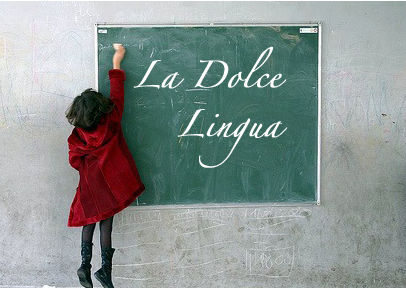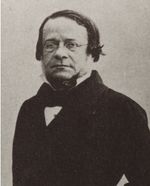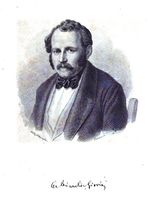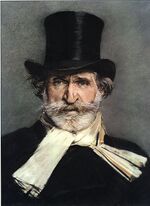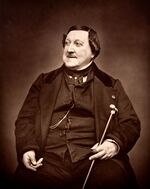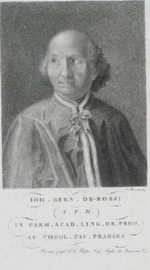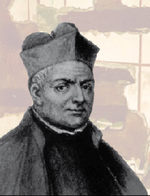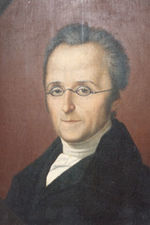Category:Italian language--1800s
History of Research (1800s) -- Notes
In the first half of the 19th century, in the climate of Italian Risorgimento, Italian scholarship produced a series of remarkable works.
It started in 1802-07 with the historiographical and bibliographical work on Jewish and Arabic literature by Giovanni Bernardo De Rossi, Professor of Oriental Studies at the University of Parma. It went on in 1820 with a jewel of Enochic research, a commentary on the Greek fragments of Enoch by sixteen-year-old Daniele Manin, and in 1844 with the work of Giuseppe Marchi on the Roman catacombs. The climax was the publication in 1844 of the Storia degli Ebrei e delle loro sette e dottrine religiose durante il secondo tempio by Aurelio Bianchi-Giovini, a comprehensive introduction to Second Temple Judaism that still today stands up for its critical analysis of ancient sources, its unapologetic view of Christian origins, and its "modern" approach to Jewish diversity. Giovini found a brilliant respondent in Samuel David Luzzatto, the leading authority of Italian Jewish scholarship of the time, who also offered in 1848-52 his view on Second Temple Judaism.
Along with the scholarly production, some works of fiction captivated the Italian imagination, gaining large popular success. The operas Ciro in Babilonia (1812) by Gioachino Rossini, and Nabucco (1842) by Giuseppe Verdi as well as the drama Ester d'Engaddi (1821) by Silvio Pellico, all focused on the Second Temple period. For some time italian patriots identified themselves with the Jews of that time, who like them were longing for freedom under the oppression of foreign nations (the Babylonians and then the Romans). To avoid censure without loosing the political implications of the story, in 1844 Giovanni Pacini gave a Second Temple Jewish setting ("in the times of Vespasian") to Eugène Scribe's drama La Juive, which Jacques Fromental Halévy had already set to music in 1835 in France in its original Inquisition setting. Pacini had already composed in 1825 another highly successful opera with a first-century setting, L’ultimo giorno di Pompei <The Last Day of Pompeii>, a work that did not make any reference to Judaism or Christianity, but would inspire Edward Bulwer Lytton's famous 1834 novel. In 1848 Giovanni Pacini also set to music Pellico's drama Ester d'Engaddi.
- @2015 Gabriele Boccaccini, University of Michigan
Pages in category "Italian language--1800s"
The following 61 pages are in this category, out of 61 total.
1
- La passione di Gesù Cristo (The Passion of Jesus Christ / 1800 Caruso / @1783 Paisiello), Perugia production (oratorio)
- Dizionario storico degli autori ebrei e dello loro opere (1802 De Rossi), book
- La clemenza di Tito (The Clemency of Titus / 1802 Del Fante / @1734 Metastasio), opera (music), Florence premiere
- La resurrezione di Gesù Cristo (1804 Weigl), oratorio
- Betulia liberata (1805 Naumann / Metastasio), oratorio
- Ester ed Assuero (1806 Catugno / Piccinni), oratorio
- Dizionario storico degli autori arabi più celebri e delle principali loro opere (1807 De Rossi), book (Italian)
- La passione di Gesù Cristo (The Passion of Jesus Christ / 1811 Morlacchi / @1730 Metastasio), oratorio (music), Dresden premiere
- Storia della vita di Gesù Cristo (1812 Pertusati) = Histoire de la vie de Jesus-Christ (History of the Life of Jesus Christ / 1786-88 Compans), book (Italian ed.)
- Il libro di Giobbe (1812 De Rossi), book
- Gerusalemme distrutta (1812 Dusik), oratorio
- Ciro in Babilonia (Cyrus in Babylon / 1812 / @1812 Rossini), Ferrara production, world premiere (opera)
- Ciro in Babilonia (Cyrus in Babylon / 1812 Rossini / Aventi), opera
- La distruzione di Gerusalemme (The Destruction of Jerusalem / 1812 Zingarelli / Sografi), opera (music & libretto), Milan premiere (cast)
- Ciro in Babilonia (Cyrus in Babylon / 1813 / @1812 Rossini), Mantua production, world premiere (opera)
- Erode (1815 Scevola), play
- Vita di Gesù Cristo e della sua religione (Life of Jesus Christ and His Religion / 1817 Cesari), non-fiction
- Volgarizzamento del trattato di Filone Ebreo su la virtù e le sue specie (1817 Mai), book
- Ciro in Babilonia (Cyrus in Babylon / 1817 / @1812 Rossini), Padua production (opera)
- Maometto (Muhammad / 1817 Winter / Romani), opera (music & libretto), Milan premiere
- Mosè in Egitto (Moses in Egypt / 1818 Rossini & Tottola), opera (music & libretto), Naples premiere
- I sette Maccabei (1818 Trento / Tarducci), opera
- Giuda Maccabeo; ossia, La morte di Nicanore (1819 Crispi / Rasi), oratorio
- Ciro in Babilonia (Cyrus in Babylon / 1820 Raimondi / Bordese), opera (music & libretto)
- Giuda Maccabeo; ossia, La morte di Nicanore (1821 Basili), oratorio
- Ester d'Engaddi (1821 Pellico), play
- ספר תורת האלהים (The Law of God / 1821 Reggio), book
- Vita e dottrina di Gesù Cristo (1822 Stolberg / Antici), non-fiction (Italian ed.)
- I tre fanciulli nella fornace di Babilonia (1824 Bonfichi / Rasi), oratorio
- Berenice in Roma (Berenice in Rome / 1824 Raimondi / Bordese), opera (music & libretto), Naples premiere (cast)
- Erode; ossia, Marianna (Herod; or, Mariamne / 1825 Mercadante / Ricciuti), opera (music & libretto), Venice premiere
- Degli ebrei: dissertazione oraziana (1826 Martorelli), book
- Giuditta (Judith / 1827 Raimondi / Tottola), opera (music & libretto)
- Filone Giudeo della Legazione a Gajo (Philo of Alexandria, Legatio ad Gaium / 1828 Belloni), book
- Il diluvio universale (The Great Flood / 1830 Donizetti / Gilardoni), opera (music & libretto), Naples premiere
- Parafrasi dei quattro Evangeli posti in armonia (1831-39 Barcellona), book
- Erodiade (Herodias / 1832 Pellico), play
- Ciro in Babilonia (Cyrus in Babylon / 1832 / @1812 Rossini), Perugia production (opera)
- Il Daniello (1834 Terziani / Giuliani), oratorio
- Ester d'Engaddi (1837 Gioja / Gabrielli), ballet
- Nabuccodonosor (Nebuchadnezzar / 1838 Cortesi), ballet
- Erodiade (Herodias / 1838 Liberali / De Horatiis), oratorio
- Le sette ultime parole di Nostro Signore Gesù Cristo (1838 Mercadante), oratorio
- Giuditta (Judith / 1840 Levi / Peruzzini), opera (music & libretto), Venice premiere
- Storia filosofica degli Ebrei: dalla declinazione de' Maccabei fino ai tempi presenti (1841 Capefigue / Marchi), book (Italian ed.)
- Nabucco (1842 Verdi / Solera), opera
- Introduzione storica e critica ai libri dell'Antico e Nuovo Testamento (1843-1847 Glaire), book (Italian ed.)
- Ester d'Engaddi (1843 Malipiero), opera
- Ester d'Engaddi (1843 Peri / Cammarano), opera
- Archittetura della Roma sotteranea cristiana (1844 Marchi), book
- L'ebrea (1844 Pacini / Sacchero), opera
- Ester (1846 Gordigiani / Barsottini), oratorio
- Ester d'Engaddi (1846 Graffigna / Cammarano), opera
- Il perfetto leggendario; ovvero, Storia della vita di Gesù Cristo (History of the Life of Jesus Christ / 1847-50 Lorini), non-fiction
- Eleazzaro; o, I Maccabei (1848 Biagi), opera
- Il giudaismo illustrato nella sua teorica, nella sua storia e nella sua letteratura (1848-1852 Luzzatto), book
- Ester d'Engaddi (1848 Pacini / Guidi), opera
Media in category "Italian language--1800s"
The following 4 files are in this category, out of 4 total.
- 1820 * Manin.jpg 138 × 200; 7 KB
- 1821 Pellico (play).png 420 × 595; 153 KB
- 1844 * Bianchi-Giovini.jpg 1,044 × 1,360; 280 KB
- 1848 Pacini (opera).jpg 293 × 500; 36 KB
